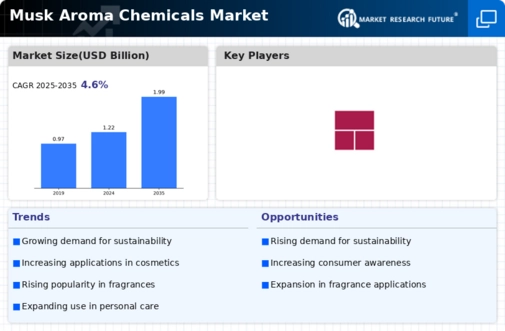Top Industry Leaders in the Musk Aroma Chemicals Market

The world of musk, with its seductive allure and enigmatic history, finds a vibrant echo in the musk aroma chemicals market. This fragrant growth story is orchestrated by a diverse ensemble of factors: rising demand for luxury fragrances, a surge in natural and synthetic musks, and the ever-evolving preferences of consumers across the globe. But beneath this aromatic aria lies a complex musical score, where industry players compete for market share, employing distinct strategies and navigating dynamic trends.
Strategies Amplifying Allure:
- Product Diversification: Leading players like Firmenich, Givaudan, and IFF are expanding their portfolios, developing new musk molecules with unique and nuanced olfactory profiles to cater to diverse consumer preferences.
- Sustainability Focus: With environmental concerns gaining traction, companies are investing in bio-based musk alternatives derived from renewable resources like patchouli or ambrette seeds, minimizing their environmental footprint.
- Vertical Integration: Some players are pursuing vertical integration, acquiring raw material suppliers or expanding into downstream production of fragrance compounds, gaining greater control over the value chain.
- Geographical Expansion: Emerging markets like China, India, and Southeast Asia offer immense potential. Companies are establishing production facilities and distribution networks in these regions to capture the surging demand for luxury fragrances.
- Partnerships and Acquisitions: Strategic partnerships and acquisitions are a common strategy to access new technologies, regional expertise, and customer bases, amplifying reach and capabilities.
Factors Dictating Market Share:
- Olfactory Profile and Uniqueness: Musk molecules with nuanced and distinctive personalities often command premium prices and attract a wider customer base.
- Cost Competitiveness and Availability: Balancing the high cost of natural musks with the affordability of synthetic options is crucial for market penetration in different segments.
- Regulatory Compliance: Meeting stringent regulations on the use of certain musk chemicals, especially in Europe and North America, is essential for market access and customer trust.
- Brand Reputation and Customer Relationships: Established brands with a strong reputation for quality and innovation in fragrance creation often enjoy market loyalty and a larger share of the pie.
- Trend Forecasting and Adaptation: Staying ahead of evolving consumer preferences for specific musk profiles and fragrance trends is crucial for sustained market success.
Key Players:
- PFW Aroma Ingredients (the Netherlands),
- Sigma-Aldrich Co. LLC. (U.S.),
- The Good Scents Company (U.S.),
- Bell Flavors & Fragrances (U.S.),
- International Flavors & Fragrances (U.S.),
- Givaudan (Switzerland),
- Firmenich (Switzerland),
- Takasago (Japan),
- Guangzhou Flower Flavours & Fragrances Co., Ltd. (China)
Recent Developments:
- September 2023: Several musk aroma chemicals producers announced price increases due to rising raw material costs and supply chain disruptions.
- October 2023: The International Society of Perfumery hosted its annual conference, focusing on advancements in musk aroma chemicals technology, sustainability initiatives, and market trends in the fragrance industry.
- November 2023: A global study highlighted the potential of functionalized musk aroma chemicals with enhanced properties like long-lasting fragrance or mood-altering effects, opening up new avenues for product design and functionality.
- December 2023: The Chinese government announced plans to invest in the development of advanced musk aroma chemicals production technologies, aiming to strengthen domestic production and compete with global

